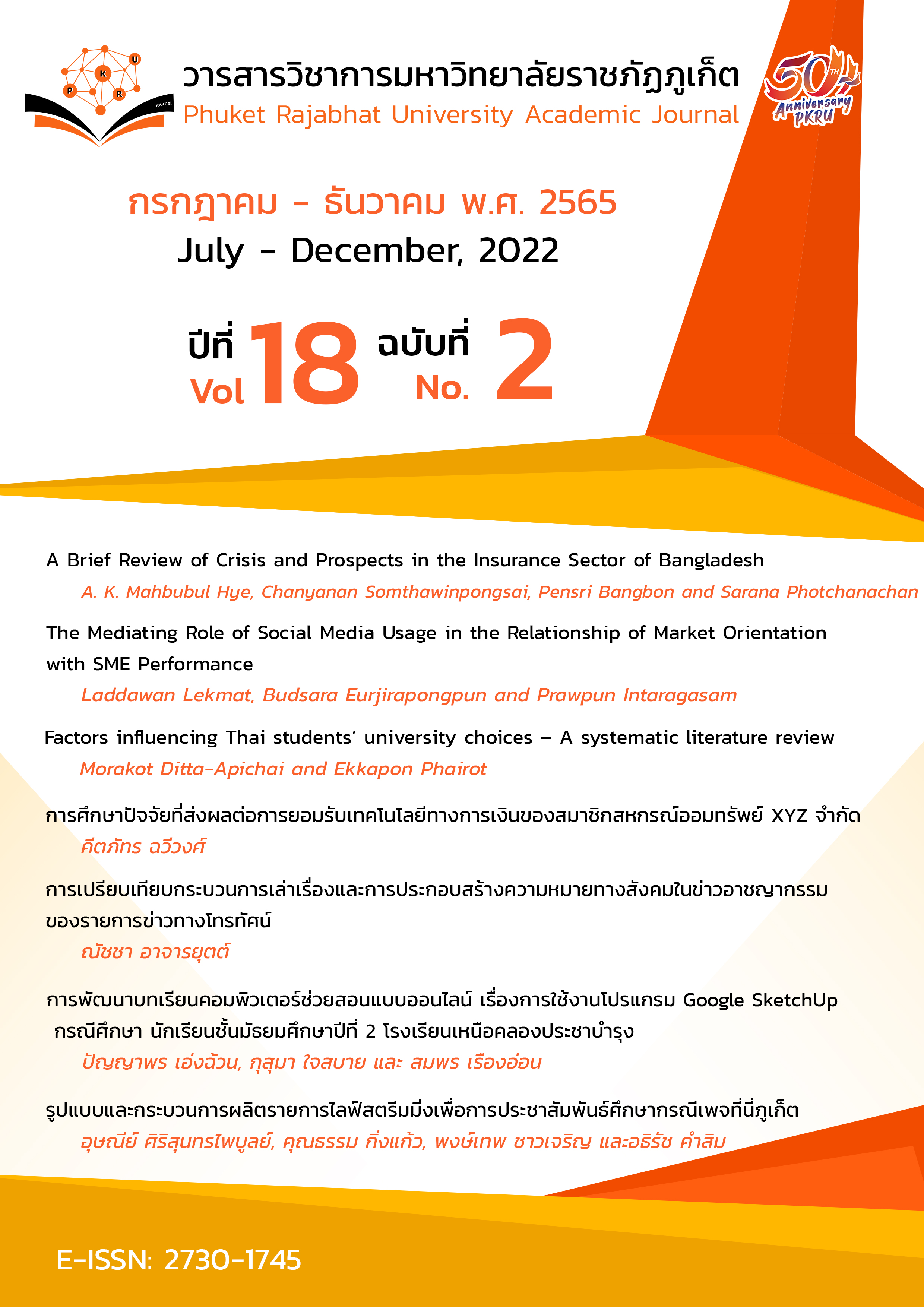การเปรียบเทียบกระบวนการเล่าเรื่องและการประกอบสร้างความหมายทางสังคม ในข่าวอาชญากรรมของรายการข่าวทางโทรทัศน์
Main Article Content
บทคัดย่อ
บทความวิจัยนี้เป็นส่วนหนึ่งของโครงการวิจัย “กระบวนการเล่าเรื่องในข่าวอาชญากรรมของสื่อมวลชนไทย : กรณีศึกษาการเสียชีวิตของน้องชมพู่ หมู่บ้านกกกอก จังหวัดมุกดาหาร” มีวัตถุประสงค์เพื่อศึกษากระบวนการเล่าเรื่องและการประกอบสร้างความหมายทางสังคมผ่านตัวละครในข่าวอาชญากรรมของสื่อมวลชนไทย เป็นงานวิจัยเชิงคุณภาพ (Qualitative research) ใช้วิธีวิจัยแบบวิเคราะห์เนื้อหา (Content analysis) ร่วมกับการวิเคราะห์ตัวบท (Textual analysis) มีขอบเขตการเก็บรวบรวมข้อมูลจากข่าวการเสียชีวิตของน้องชมพู่ หมู่บ้านกกกอก จังหวัดมุกดาหาร ในรายการทุบโต๊ะข่าว อัมรินทร์ทีวี 34 และรายการไทยรัฐนิวส์โชว์ ไทยรัฐทีวี 32 เป็นระยะเวลารวม 14 เดือน
ผลการวิจัยพบว่ารายการทุบโต๊ะข่าว อัมรินทร์ทีวี 34 และรายการไทยรัฐนิวส์โชว์ ไทยรัฐทีวี 32 ใช้วิธีการเล่าเรื่องไม่แตกต่างกันโดยอ้างอิงโครงสร้างการเล่าเรื่องแบบบันเทิงคดี กำหนดแก่นเรื่อง โครงเรื่อง ตัวละคร ฉาก บทสนทนาและกลวิธีการเล่าข่าว นอกจากนี้ยังสร้างความหมายที่ลื่นไหลให้ตัวละคร สลับบทบาทผู้กระทำและผู้ถูกกระทำตามช่วงเวลา พยาน หลักฐาน ทำให้เกิดภาพลักษณ์ของข่าว และบุคคลในข่าวแตกต่างกัน ซึ่งมีวิธีการประกอบสร้างความหมายให้กับตัวละครในข่าว จำนวน 6 รูปแบบ ได้แก่ การเปิดไทม์ไลน์บุคคล การหาหลักฐานและพยานด้วยตัวผู้สื่อข่าว การอ้างอิงผู้เชี่ยวชาญและตำรวจ การนำเสนอแบบเร้าอารมณ์ การใช้ภาษาให้คุณค่าเชิงบวกและเชิงลบต่อตัวตัวละครในข่าว และการอ้างอิงความเชื่อเรื่องเหนือธรรมชาติ
Article Details

อนุญาตภายใต้เงื่อนไข Creative Commons Attribution-NonCommercial-NoDerivatives 4.0 International License.
เนื้อหาและข้อมูลในบทความที่ลงตีพิมพ์ในวารสารวิชาการมหาวิทยาลัยราชภัฏภูเก็ต ถือเป็นข้อคิดเห็นและความรับผิดชอบของผู้เขียนบทความโดยตรง ซึ่งกองบรรณาธิการวารสารฯ ไม่จำเป็นต้องเห็นด้วยหรือร่วมรับผิดชอบใด ๆ
บทความ ข้อมูล เนื้อหา รูปภาพ ฯลฯ ที่ได้รับการตีพิมพ์ในวารสารวิชาการมหาวิทยาลัยราชภัฏภูเก็ต ถือเป็นลิขสิทธิ์ของวารสารวิชาการมหาวิทยาลัยราชภัฏภูเก็ต หากบุคคลหรือหน่วยงานใดต้องการนำทั้งหมดหรือส่วนหนึ่งส่วนใดไปเผยแพร่ต่อหรือเพื่อกระทำการใด ๆ จะต้องได้รับอนุญาตเป็นลายลักษณ์อักษรจากวารสารวิชาการมหาวิทยาลัยราชภัฏภูเก็ตก่อนเท่านั้น
เอกสารอ้างอิง
Anantho, S., & Thongrin, S. (2016). Ethics in the media profession. Mahidol University Press.
Bird, S. E., & Dardenne, R. W. (1988). Media, myths, and narratives - television and the press. Sage Publications.
Chavalathawat, P. (2000). Advanced news reporting (3rd ed.). Double nine publishing house.
Chermarn Cholamak, C. (2005). Narrative and the science of storytelling. (Narratology). Academic journal faculty of communication arts Rangsit University, 9(1), 41-46.
Chumnankit, T., & Siriborvornratanakul, T., (2020). Thai fake news detection using natural language processing. KMUTT Research & Development Journal, 45(2), 275-287.
Conboy, M. (2007). The language of the news. Routledge.
Fiske, J. (2011). Introduction to Communication Studies (3rd ed.). Routledge.
Kaewthep, K. (2011). Mass communication: Theory and educational approaches. Pabpim.
Konkuntod, P. (2017). Presentation of crime news in online media: a case study of undergraduate students of the faculty of education. Kasetsart University Bang Khen Campus. [Master’s thesis]. Kasetsart University.
McQuail, D. (2009). Mass communication theory (3rd ed.). Sage Publications.
Mingmuang, A. (1992). News storytelling "on the radio". [Master’s thesis]. Chulalongkorn University.
Muendao, A. (2017). Crime news phenomenon in the media 2.0 : The view and experience of Alongkorn Muendao. Retrieved June 12th, 2017, from https://www.voicetv.co.th
Nusartlert, A., & Limsangkat, S. (2017). Comparison of crime headlines in local newspapers and their social reflections. In Pattani and Khon Kaen: A study in social linguistics. journal of the humanities, 24(1), 200-221.
Office of the National Cultural Commission. (2008). Culture and Change. Bangkok. Amarin printing and publishing.
Panich, A. (2001). Language and writing principles for communication. Chulalongkorn University Press.
Pansonthi, C., & Chanwichai,K. (2013). The media performance of news story programs: a case study of Thai color television station, Channel 3. Business Administration Journal. Economics and communication, 8(2), 55-65.
Pongsawat, P. (2017). Crime news and the real world. Matichon Online, Retrieved June 6th, 2017, from https://www.matichon.co.th
Premsriratana, U. (2015). Storytelling in communication arts: A study from research. NIDA Journal of communication arts and innovation, 2(1), 31-58.
Reungsak, P. (2011). Crime news and newspaper storytelling. Executive journal, 37(26), 205-211.
Ruangskul, A. (1998). An analysis of narratives on the front page of daily newspapers. [Master’s thesis, Chulalongkorn University]. Chulalongkorn University Intellectual Repository (CUIR). Retrieved May 15th, 2020, from http://cuir.car.chula.ac.th/handle/123456789/71206
Shu, K., Awadallah, A., Dumais, S., & Liu, H. (2019). Detecting Fake News with Weak Social Supervision. IEEE Intell. Syst. 36(4), 96-103.
Tailangka, S. (2017). The science and art of storytelling (3rd ed.). Amarin printing and publishing.
Tailunga, I. (2003). The Science and Art of Storytelling (2nd ed.). Kasetsart University.
Teeravanich, S. (1996). History of Newspapers in Thailand under Absolute Monarchy. Faculty of Communication Arts, Chulalongkorn University.
TV digital watch. (2020). Rating ratings for television programs. Retrieved June 14th, 2020, from www.tvdigitalwatch.com/category/tv-rating/rating-anual.
Wonglaksanaphan, A. (1999). The narration of political news in Thai newspapers. [Master’s thesis, Chulalongkorn University]. Chulalongkorn University Intellectual Repository (CUIR). Retrieved June 12th, 2019, from http://cuir.car.chula.ac.th/handle/123456789/9056


